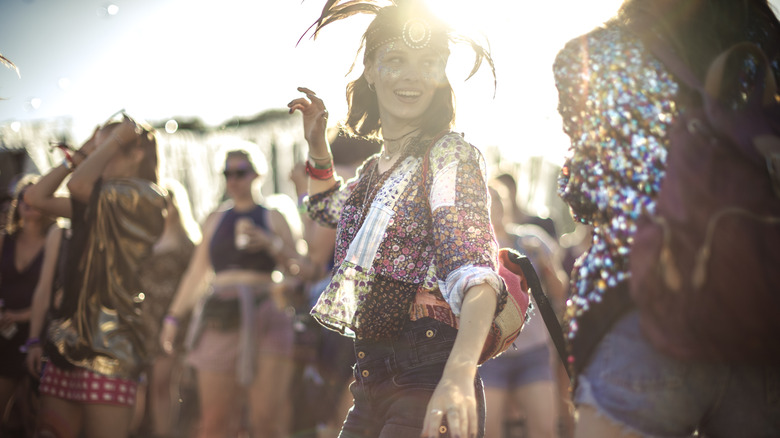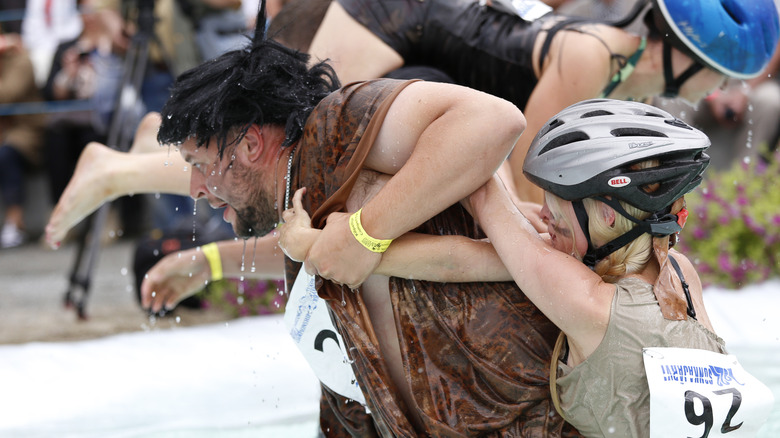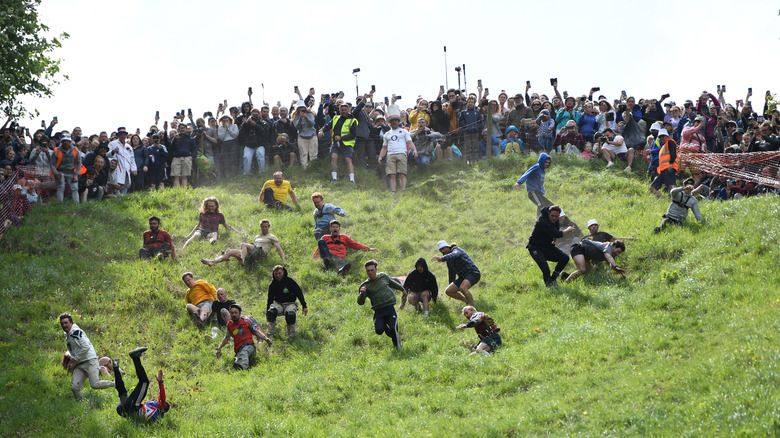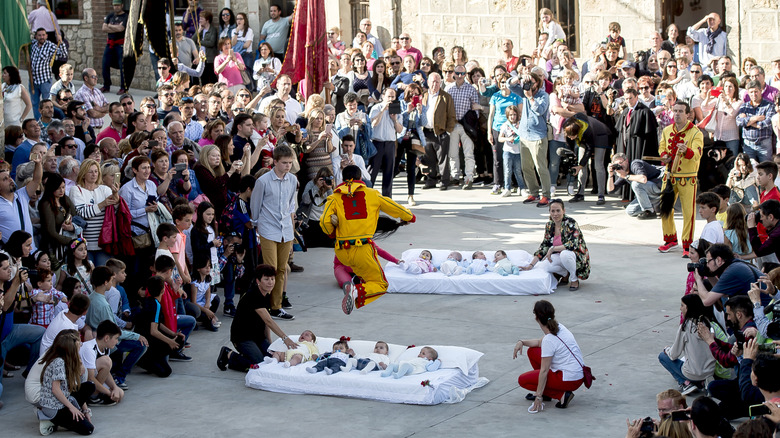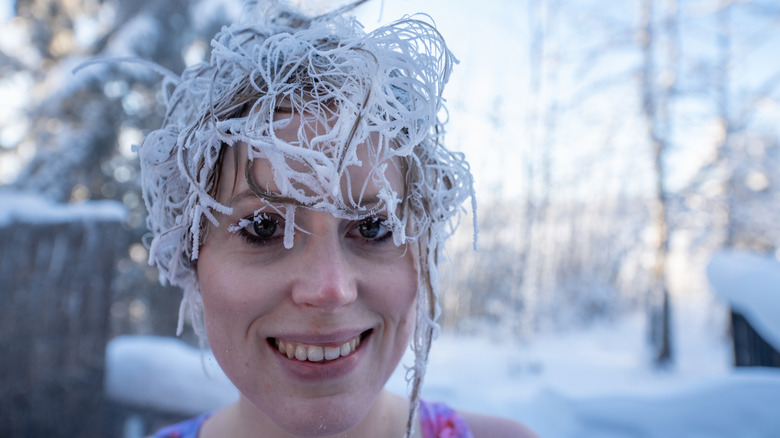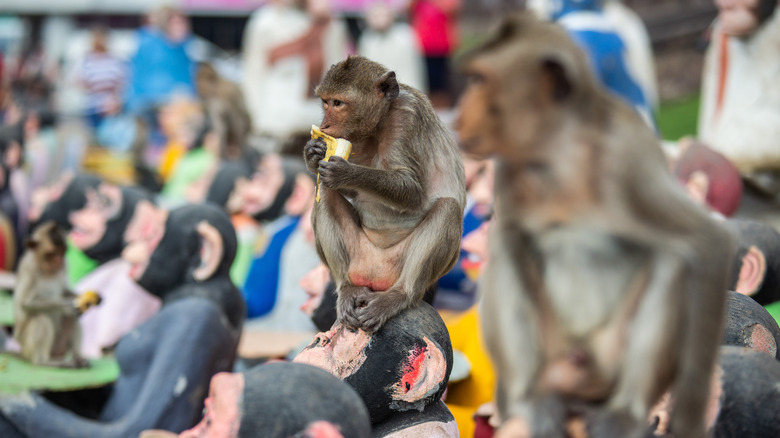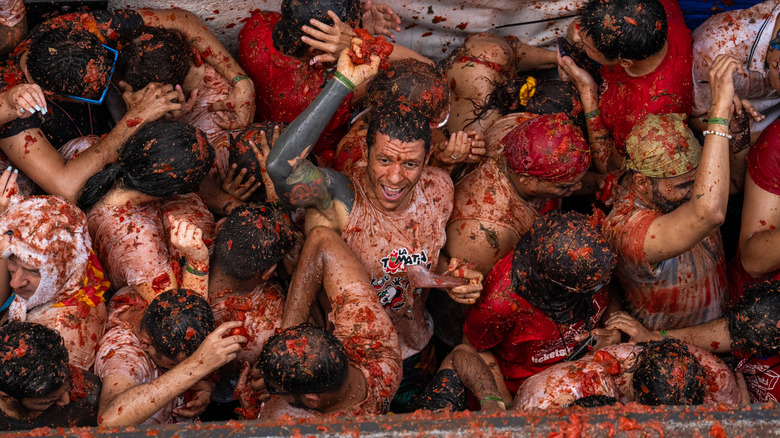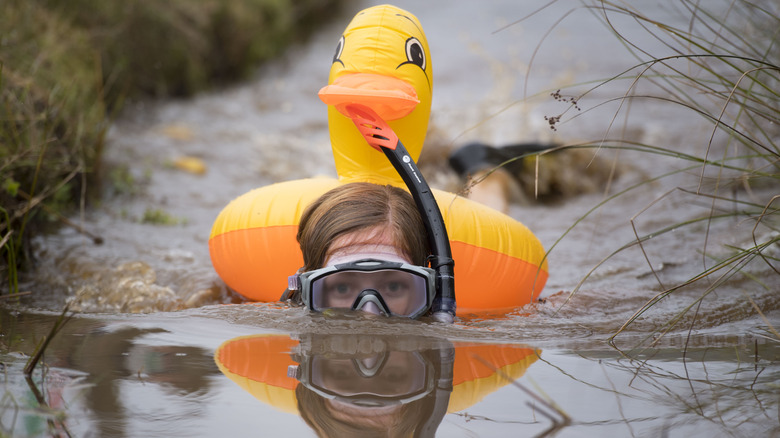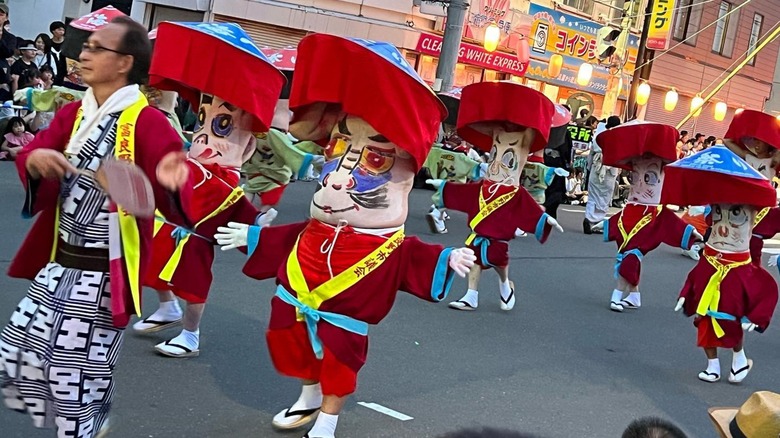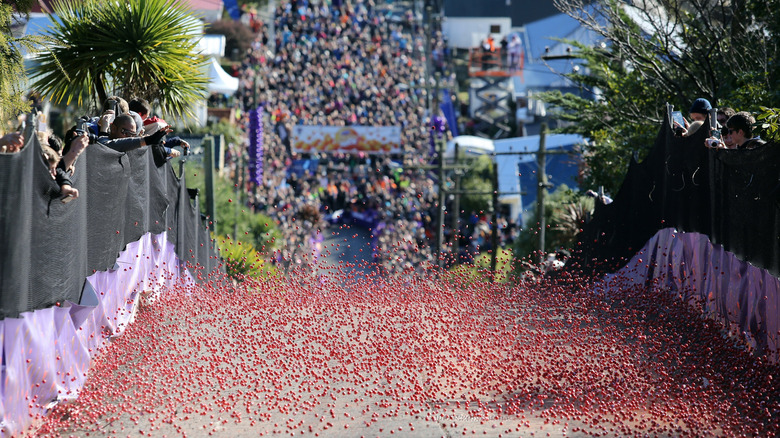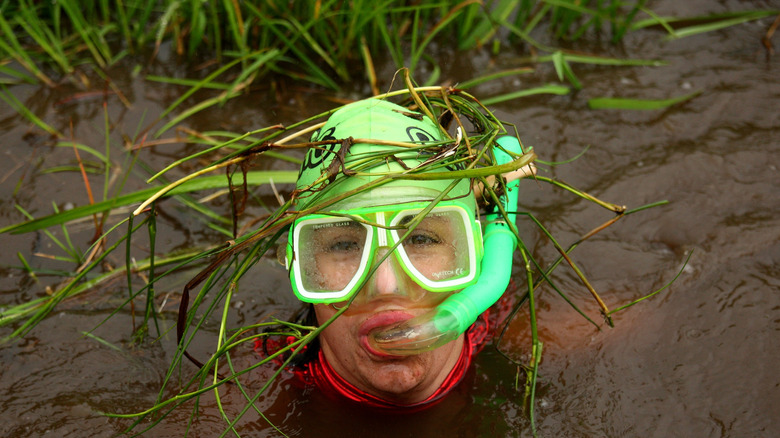11 Truly Bizarre Festivals Around The World We Can't Believe Exist
You've likely heard of Burning Man, the colorful celebration of all things artsy and spiritual, and are no stranger to the California desert oasis that is the iconic Coachella. But what about some of the whackier festivals celebrated around the world? Believe it or not, it can get a whole lot weirder than burning effigies in the middle of Nevada.
From the tropical islands of Thailand to the freezing tundra of the Yukon and everywhere in between, humans have found unique ways to honor their culture and heritage. These bizarre events happen for all sorts of reasons, from celebrating local wildlife or memorializing an important chapter in history to paying respect to the passing of the seasons, highlighting interesting geographic quirks, and more. But the through-line is simple: It's all about having fun. If life's got you down or you're just itching to plan a trip with an extra dose of whimsy, consider adding one of the most surprising annual festivals held around the globe to your next itinerary.
Wife Carrying World Championship - Sonkajärvi, Finland
One of the most peculiar festivals in the world is "eukonkanto" — aka the wife-carrying competition, which originated in Sonkajärvi, Finland, in 1992. The contents of the festival are exactly what the title suggests: Male competitors race through a massive 831-foot obstacle course while carrying their female partners over their shoulders.
In fact, there are multiple options for how to carry your wife during the race. Some opt for a piggyback style, others a fireman's carry. Any duo looking for a real challenge might opt for an Estonian-style hold. This is where the woman wraps her legs around her husband's shoulders, hanging upside down for the duration of the course. The best part? The winning duo is gifted a stein of beer that weighs the same as the woman who was carried.
Though the competition launched as a fun-wheeling race in the 1990s, experts believe that it has its origins in the 1800s. It's thought that the original "wife carrier" was Finnish Robin Hood figure Ronkainen the Robber. This thief-turned-folk-hero was known for stealing food and women from nearby towns before retreating back into the forest. A less sensational theory says that Ronkainen auditioned wannabe members of his gang by forcing them to carry heavy bags through a boulder-riddled obstacle course. Whatever the truth, this festival continues to celebrate the nation's heritage and invites others to dive deep into a little-known corner of Finnish history.
Cheese Rolling - Gloucestershire, England
Forget Glastonbury; one of England's most underrated festivals is the Gloucestershire Cheese Rolling Festival. Every Spring bank holiday, hundreds of eyewitnesses and competitors flock to Cooper's Hill in Brockworth, Gloucestershire, not to watch a music concert, but something altogether more bizarre (and delicious).
This race is a unique way to celebrate Gloucestershire culture, as participants hurl down the steep and grassy Cooper's Hill, chasing a frisbee-like wheel of Double Gloucester cheese. Cooper's Hill was chosen for being the steepest in Gloucestershire, standing at a whopping 180 meters high. With this dramatic incline, contestants have no hope of staying on their feet during the duration of the race.
Every year, images from the Springtime festival go viral, with the internet shocked at photos of hordes of people tumbling head over feet. And yet, for all that effort, the cheese is never actually caught! Reaching speeds of 80 mph, the Double Gloucester rolls at breakneck speeds and will forever be out of reach. Instead, the winner of the Gloucestershire Cheese Rolling Festival is simply the first person to cross the finish line marked at the bottom of Cooper's Hill. Dating back to at least 600 years ago, many believe that cheese rolling originated as an ancient festival that saw pagan communities mark the changing of the seasons.
Baby Jumping Festival - Castrillo de Murcia, Spain
Although it has roots in both Christianity and Paganism, this unusual Spanish festival now exists in a league of its own. Held every June in the village of Castrillo de Murcia, the Baby Jumping Festival is part theater show, part athletic event. Yes, baby jumping.
In an eccentric display, actors dressed in red and yellow masks race through the village streets, whipping participants with a horsetail whip and insulting onlookers. These are meant to be "devils," representing all the evil that exists in the world. However, when drums sound through the streets, a group of actors representing goodness begins to chase the masked fiends. This is known as El Salto del Colacho — the flight of the devil.
This is where the real bizarre display begins. As the costumed baddies race through Castrillo de Murcia, a select number of babies born the year prior are nestled onto mattresses in the middle of the street. The idea is that, by leaping over these cuties, the devil absorbs their sins, thus cleansing them of any disease and adversity. With their good luck sealed, the babies are sprinkled with rose petals and returned to their guardians. As odd as it might sound, it's believed that this ritual dates back all the way to the 1620s, either as a Christian festival on the Sunday following the Feast of Corpus Christ or as a pagan fertility ritual, hence the babies being a central element.
International Hair Freezing Contest - Whitehorse, Yukon, Canada
The capital of Canada's Yukon is a town brimming with Gold Rush history, creative vibes, and wilderness. Oh yeah, and did we mention some seriously creative festival organizers? In one of the strangest competitions on the globe, the city of Whitehorse is transformed into the headquarters of the International Hair Freezing Contest.
Held at the Eclipse Nordic Hot Springs, this competition sees contestants taking to the warm waters, wetting their hair, and then seeing which unique frosty shapes start to take place. The Yukon in winter is one of the only places this competition could be held, as hair won't freeze unless temperatures drop to a minimum of 25 degrees Fahrenheit. Luckily, the competition is not held on a single day, but is open to photo submissions throughout the season, with the winners announced in the spring. This allows for fluctuating weather patterns and assures that the competition can continue occurring annually.
The categories include Best Female, Best Male, Best Group, Best Facial Hair, Most Creative, and People's Choice. However, it's not all just fun and games: The winners of each category get to take home $2,000 in addition to Tinder-worthy photos and heaps of bragging rights. It's a quirky competition that matches the vibe of the quirky, frosty town of Whitehorse. A local speaking to The Independent said, "It's a place that attracts misfits who do fun things for the sake of it."
Monkey Buffet Festival - Lopburi, Thailand
Unforgettable adventures await in Thailand, especially if you visit in late November. Every year, on the last Sunday of the month, the ruins of the Phra Prang Sam Yot temple in Lopburi welcome a rush of tourists, photographers, and locals all there to see one thing: Thousands of macaque monkeys enjoying a feast of melons, oranges, bananas, and more.
The Monkey Buffet Festival is an important event in the provincial capital city. The festivities begin with an opening ceremony where performers don money costumes and perform a joyous dance. When the guests of honor arrive, sheets are removed from tables to reveal intricate feasts of fruits and veggies. Macaques climb, jump, and feast on stacks of watermelon, durian, lettuce, pineapple, and more. It isn't unusual for the animals to devour nearly two tons of food during the event.
While it may seem silly to Westerners, reverence for monkeys has its roots in the Hindu epic tale, the Ramayana, which is at least 2,000 years old. Telling the exploits of the prince Rama and his damsel-in-distress, Sita, one crucial episode sees Rama having to rescue Sita from a demon. Victory is only won after Rama receives help from Hanuman, a monkey king, and his troops. With the tale, monkeys became long-standing symbols of good luck and success. Today, this Thai feast is a way for believers to show appreciation for their beloved primate friends.
La Tomatina - Buñol, Valencia, Spain
Were you unable to live out your food-fight dreams in high school? Don't despair; this stunning Spanish festival is determined to bring that playful fantasy to life. Held on the last Wednesday of August every year, La Tomatina sees thousands of people flock to the town of Buñol to participate in what has been dubbed the "World's Largest Food Fight."
Get ready to get red, though, as the only food being thrown here is tomatoes — hence the name. Throughout the course of the food fight festival, around 100 tons of fall-off-the-vine tomatoes will be pulverized on the cobblestone streets of Buñol. While debates about the festival's origins continue to rage on, it is known that the first city-wide food fight occurred in either 1944 or 1945.
Some believe it began as a school group's prank, while others believe it originated at a carnival parade. One popular theory states that the first La Tomatina occurred when unfavorable city councilmen were attacked with tomatoes during a public celebration. Either way, today, the festival is all about having fun and bringing out your inner child. If this sounds like your dream, you may want to act quickly, as only 20,000 tickets are sold each year to help manage the massive, juice-covered crowds.
World Bogsnorkeling Championships - Llanwrtyd Wells, Wales
Sand dunes, dramatic waterfalls, and sweeping sea views fill the walking path that surrounds the breathtaking Welsh coastline. However, one little-celebrated feature of Wales is its muddy peat bogs. It's in these unique wetland areas, characterized by muddy waters, where you can see swimmers donning their breathing tubes and snorkeling goggles as they compete in the Rude Health World Bogsnorkeling Championships.
Taking place every August bank holiday weekend, this messy swimming race is not for the faint of heart. Believe it or not, bogsnorkeling is a real sport, and the competitors in this unique competition are professionals at what they do. Every year, 150 bogsnorkelers take a deep dive into the aquatic trench found in the Waen Rhydd bog in Wales. In the 30 years it has been running, the Rude Health World Bogsnorkeling Championships has expanded its horizons to include swimmers from as far as Australia, the Czech Republic, and more.
Unlike many other bizarre festivals around the world, this competition doesn't have roots in ancient religions. In fact, the idea came to fruition in the Neuadd Arms, a pub in the Mid-Wales village of Llanwrtyd Wells. Despite the undeniable weirdness of this sport, it's an undeniably raucous event for anyone who enjoys sipping on local ale and spectating one of the more unique sports Europe has to offer.
Air Guitar World Championship - Oulu, Finland
Looking for the hottest (and strangest) ticket in the world this August? Check out the Air Guitar World Championships. This bizarre music-centered event has been hosted in the Finnish city of Oulu since 1996 and continues to be held in the Land of a Thousand Lakes every summer. Drawing crowds from the city streets of Helsinki to the seas of Japan, the cold mountains of Canada, and more, this fun-loving festival is exactly what you might expect; enthusiastic crowds cheer on as international contestants climb the stage to rock out on an invisible stringed instrument.
Whoever puts on the most energetic, inventive, and realistic performance is crowned Air Guitar World Champion. The reasoning behind this magical event? According to the organizers, the hope is that this event promotes joyous living, which in turn promotes overall world peace and equality. The philosophy behind playing the air guitar on such a large stage is that there is no barrier to entry — anyone can have a go at strumming along to a make-believe stringed instrument no matter their age, gender, ethnicity, or years of experience.
In fact, the Air Guitar World Championships have received the approval of EcoCompass, an environmental management system that helps companies keep their facilities and practices ultra-green and earth-friendly. Although the competition is a major event with multiple rounds of performances, their commitment to green energy and advocacy for peace proves that it's about way more than strumming air guitars.
Cheung Chau Bun Festival - Cheung Chau, Hong Kong
If you're thinking about booking a flight to Hong Kong in the future, then you may want to think about looking into prices for the Springtime, as this is when the quirky Taoist celebration known as the Cheung Chau Bun Festival takes place on Cheung Chau Island. In 2020, the event occurred in April, while the following years have seen the yeasty celebration kick off in May. Check the calendar and get yourself booked.
Dating back to the plague time, the bun festival has its origins in the tale of Pak Tai, a Taoist god of the North and protector of fishermen. It is believed that the deadly plague finally left Cheung Chau Island because an image of Pak Tai was paraded through the streets, thus driving away sickness from the homes of his worshippers.
Today, tourists from all over Hong Kong and international bun-lovers pile into Cheung Chau to celebrate what is also known as the "Da Jiu" festival. However, the serious origins of the festival have been replaced with light-hearted events meant to mark the end of spring. There are lion dances and carnivalesque parades that see children take to the streets in costume, but by far the most bizarre attraction is the Bun Scrambling Competition. This sees participants scramble up three large towers stickered with sticky steamed buns — an iconic local delicacy. Contestants must climb the towers and reach the top to claim their glory.
Hokkai Heso Matsuri - Furano, Hokkaido, Japan
Are you in love with your hometown? No matter how strong your passion for your zip code might be, it's unlikely that you feel as much pride as those who hail from Furano City in the Japanese prefecture of Hokkaido. Located in the middle of the prefecture, Furano locals host the Furano Bellybutton Festival — aka the Hokkai Heso Matsuri — every July to honor the city's history of being known as the "belly button" of the region.
Beginning in 1969, the tongue-in-cheek celebration of all things belly button and Furano-related is imbued with as much whimsy as you might expect from an event created just a few years after the Summer of Love. Legend has it that only 11 people turned up for the first iteration of the event, but today, the Bellybutton Festival can draw crowds of up to 5,000. Although the festival is rooted in love for Furano, the festival's reputation has now spread across the globe, enticing visitors from all over the world.
The biggest draw? The Hokkai belly button dance competition. Participants are invited to paint, draw, and color dramatic faces — aka Zubaras — on their bellies and stomp through the city streets, performing as their characters. Additionally, tourists and locals alike are treated to other belly-related events, such as the belly button gourmet. Energizing local restaurants, this celebratory feast sees Furano's chefs and restaurateurs serving dishes that have a connection to the belly button.
Jaffa Race - Dunedin, New Zealand
This mesmerizing New Zealand tradition is one of the most chocolate-filled and whimsical festivals in the world. Every July, Baldwin Street in the South Island city of Dunedin welcomes thousands of sweet lovers to the Jaffa Race. Celebrating the fact that Baldwin Street is known as the steepest street in the world, locals and tourists alike celebrate this peculiar gem of New Zealand infrastructure by rolling 75,000 Jaffa lollies down the hallowed pavement.
Created by the chocolate company Cadbury's, Jaffas are tiny, round chocolate bites that are encased by an iconic red shell, similar to an M&M. Not widely consumed, these little snacks are most popular in Australia and New Zealand. These melty treats roll pretty fast and can reach up to 60 mph. And although you may think it's impossible to tell which Jaffa crosses the finish line first, the facilitators are meticulous about determining exactly which chocolate ball won.
The trick is this: Each Jaffa is numbered, and participants are asked to pay $1 for their Jaffa, almost like horse race betting. The "running of the balls," as it is called, is done three times in a row, and those who put a ticket down for the winning Jaffa in each round are awarded prizes (and gloating rights). A charity event, the Jaffa Race has been running since 2001, with all proceeds going to local Dunedin charities — Willy Wonka would be proud.
Methodology
To uncover the most truly bizarre festivals around the world, we dove deep into the far corners of the internet, from quirky travel blogs to obscure cultural databases, sifting through the most jaw-dropping, unusual events that make you do a double-take. Our criteria? We looked for festivals that not only had us scratching our heads in disbelief but also offered a genuine glimpse into unique cultural traditions, such as long-held religious beliefs, culinary histories, geographic quirks, and more.
We considered everything from the sheer oddity of the event itself to the festival authenticity (no marketing schemes to be found here) to the level of participation (because who doesn't want to throw tomatoes or race chocolate cookies down a hill?). After combing through hundreds of obscure celebrations, we handpicked the festivals that are the most bizarre, entertaining, and infectious with their joy. These festivals might make you question how boring our old stateside festivals really are, but one thing's for sure — after reading this list, you'll never look at a festival the same way again.
